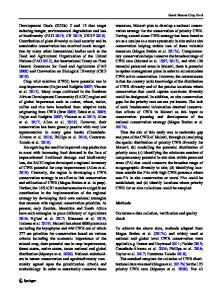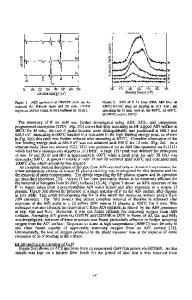In Situ and Ex Situ Studies of Tetrammineplatinum(II) Chromate Thermolysis
- PDF / 1,074,749 Bytes
- 5 Pages / 612 x 792 pts (letter) Page_size
- 63 Downloads / 308 Views
DINATION COMPOUNDS
In Situ and Ex Situ Studies of Tetrammineplatinum(II) Chromate Thermolysis V. I. Lagunovaa, b, *, E. Yu. Filatova, P. E. Plyusnina, and S. V. Koreneva aNikolaev
Institute of Inorganic Chemistry, Siberian Branch, Russian Academy of Sciences, Novosibirsk, 630090 Russia b Novosibirsk State University, Novosibirsk, 630090 Russia *e-mail [email protected] Received March 18, 2020; revised May 4, 2020; accepted May 27, 2020
Abstract―Comparative analysis have shown that the thermolysis of complex salt [Pt(NH3)4]CrO4 in synthetic air atmosphere under in situ and ex situ conditions proceeds in different routes. In contrast to in situ experiment, ex situ decomposition leads to formation of intermediate PtCrO2 phase with delafossite structure. Final decomposition product is a homogeneous mixture of platinum metal and chromium(III) oxide. Complex [Pt(NH3)4]CrO4 has been shown to have negative volumetric coefficient of thermal expansion in the temperature range 30–200°C (–1.9 × 10–5 1/K). Ex situ experiments have shown stability of the complex on consecutive cyclic heating to 200°C and cooling to ambient temperature Keywords: nanoparticles, platinum, thermal analysis, in situ X-ray diffraction, negative volumetric coefficient of thermal expansion DOI: 10.1134/S0036023620100150
INTRODUCTION Complex salts containing two metals are of interest as precursors for preparing various nanosized metallic and metal oxide materials [1–3]. The process of thermal decomposition of coordination compounds is mainly dependent on thermolysis atmosphere and sample heating rate. The composition of final decomposition products varies depending on thermal destruction conditions and the composition of initial complex salt [4–6]. Metallic and metal oxide nanoparticles resultant from decomposition of these compounds can have unique physicochemical properties, e.g., electrical conduction. For example, nonstoichiometric delafossite Cu0.66Cr1.33O2 has the highest electrical conductivity among semiconductor oxides of p-type [7], which enables one to use it in solar cells, sensor monitors, and light-emitting diodes [8]. Metal nanoparticles also can show magnetic properties. For example, Fe–Ni alloy shows high magnetization and magnetic permeability [9], therefore this compound is used as a magnetic material to design different items by stencil process. The items produced by this method shows high magnetic permeability and can be used in different inductors and transformers. Nanosized bimetallic compounds are widely used as catalysts in organic and inorganic chemistry for scientific and industrial applications [10–12]. One of examples of industrial application of catalysts based on nanoalloys is the use of Pd–Ni alloy applied on
nickel foam for oxygen removal from methane in coalbed [13]. Catalysts obtained by the thermolysis of complex salts containing platinum as metal center can be also used in industrially significant reactions. In the work [14], the process of thermal decomposition of complex salts [Pt(NH3)4]C2O4 and [Pt(NH3)
Data Loading...









